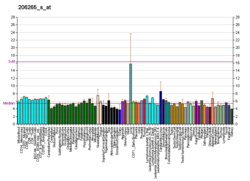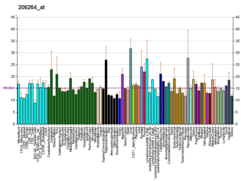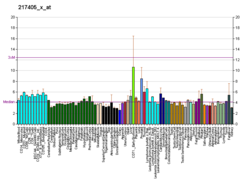Phosphatidylinositol-glycan-specific phospholipase D is an enzyme that in humans is encoded by the GPLD1 gene.[5][6]
Many proteins are tethered to the extracellular face of eukaryotic plasma membranes by a glycosylphosphatidylinositol (GPI) anchor. The GPI-anchor is a glycolipid found on many blood cells. The protein encoded by the GPLD1 gene is a GPI degrading enzyme that hydrolyzes the inositol phosphate linkage in proteins anchored by phosphatidylinositol glycans, thereby releasing the attached protein from the plasma membrane.[6]
Plasma concentrations of Gpld1 in mice were found to increase after exercise and to correlate with improved cognitive function, and concentrations of GPLD1 in blood were increased in active elderly humans.[7][8]
- ^ a b c GRCh38: Ensembl release 89: ENSG00000112293 – Ensembl, May 2017
- ^ a b c GRCm38: Ensembl release 89: ENSMUSG00000021340 – Ensembl, May 2017
- ^ "Human PubMed Reference:". National Center for Biotechnology Information, U.S. National Library of Medicine.
- ^ "Mouse PubMed Reference:". National Center for Biotechnology Information, U.S. National Library of Medicine.
- ^ Schofield JN, Rademacher TW (November 2000). "Structure and expression of the human glycosylphosphatidylinositol phospholipase D1 (GPLD1) gene". Biochimica et Biophysica Acta (BBA) - Gene Structure and Expression. 1494 (1–2): 189–94. doi:10.1016/s0167-4781(00)00194-9. PMID 11072085.
- ^ a b "Entrez Gene: GPLD1 glycosylphosphatidylinositol specific phospholipase D1".
- ^ Horowitz AM, Fan X, Bieri G, Smith LK, Sanchez-Diaz CI, Schroer AB, et al. (July 2020). "Blood factors transfer beneficial effects of exercise on neurogenesis and cognition to the aged brain". Science. 369 (6500): 167–173. Bibcode:2020Sci...369..167H. doi:10.1126/science.aaw2622. PMC 7879650. PMID 32646997. S2CID 220428681.
- ^ Harris R (9 June 2020). "An Enzyme That Increases With Exercise Can Improve Memory In Mice, And Maybe People". National Public Radio.






